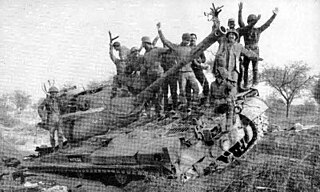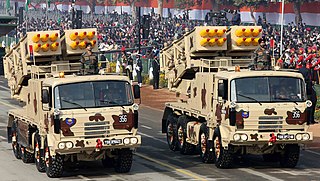
The 4th Infantry Division, also known as the Red Eagle Division, is an infantry division of the Indian Army. This division of the British Indian Army was formed in Egypt in 1939 during the Second World War. During the Second World War, it took part in campaigns in East Africa, Syria, North Africa and Italy. Post independence, the division is part of the I Corps and headquartered at Prayagraj.
39th Indian Infantry Division was an infantry division of the Indian Army during World War II, which became a training division in 1943 after its recovery into India from Burma. The division was re-raised after independence and 39 Mountain Division is presently located in Palampur, Himachal Pradesh under XVI Corps.

The Battle of Basantar, also known as the Battle of Shakargarh or Battle of Barapind, was one of the vital battles fought as part of the Indo-Pakistani War of 1971 in the western sector of India. The Indian troops won a hard-fought battle that secured this area in the Punjab/Jammu sector. The name Battle of Basantar actually encompasses the entire gamut of battles and skirmishes fought in the Shakargarh sector.

The 2nd Division was an infantry division of the Indian Army during World War II and was disbanded in 1944. In its present form, 2 Mountain Division, raised in 1962, is part of the Indian Army.

The 10 RAPID Division was a war formed infantry division of the Indian Army during World War II. In four years, the division travelled over 4,000 miles (6,400 km) from Tehran to Trieste, fought three small wars, and fought two great campaigns: the Anglo-Iraqi War, the Invasion of Syria–Lebanon, the Anglo-Soviet invasion of Iran, the North African Campaign, and the Italian Campaign.
The 11th Indian Infantry Division is an infantry division of the Indian Army. It was raised as a part of the Indian Army during World War II. It formed part of Indian III Corps in the Malaya Command during the Battle of Malaya. The division was re-raised on 1 April 1965 and is presently part of the XII Corps of Southern Command. It is presently responsible for safeguarding the borders with Pakistan along Southern Rajasthan and Gujarat.

The 15th Indian Division was an infantry division of the British Indian Army that saw active service in the First World War. It served in the Mesopotamian Campaign on the Euphrates Front throughout its existence. It did not serve in the Second World War, but was reformed at Dehradun in 1964 as part of the post-independence Indian Army.
40 Field Regiment (Asal Uttar), nicknamed the Roaring Forty is part of the Regiment of Artillery of the Indian Army.
36 Medium Regiment is an artillery regiment which is part of the Regiment of Artillery of the Indian Army.
1841 Light Regiment is a regiment which is part of the Regiment of Artillery of the Indian Army.
17 Parachute Field Regiment is part of the Regiment of Artillery of the Indian Army.
91 Field Regiment (Asal Uttar) is part of the Regiment of Artillery of the Indian Army.
1851 Light Regiment is part of the Regiment of Artillery of the Indian Army.
15 Medium Regiment is part of the Regiment of Artillery of the Indian Army.
32 Field Regiment is part of the Regiment of Artillery of the Indian Army.

841 Rocket Regiment is part of the Regiment of Artillery of the Indian Army.
51 Medium Regiment is part of the Regiment of Artillery of the Indian Army.
44 Field Regiment is part of the Regiment of Artillery of the Indian Army.
60 Medium Regiment is part of the Regiment of Artillery of the Indian Army.
13 Field Regiment (Chushul and Gadra City) is part of the Regiment of Artillery of the Indian Army, and has the distinction of having two post-independence honour titles.






